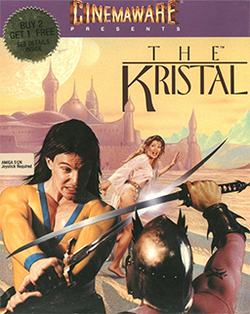| The Kristal | |
|---|---|
 | |
| Developer | Fissionchip Software |
| Publishers | Addictive Games Cinemaware |
| Director | Michael Sutin |
| Producer | Mark Pearce |
| Designers | Rodney Wyatt Michael Sutin |
| Programmer | Alan Butcher |
| Artist | Michael Haigh |
| Writer | Michael Sutin |
| Composers | Rodney Wyatt Mickey Keen |
| Platforms | Amiga, Atari ST, MS-DOS |
| Release | |
| Genre | Adventure game |
| Mode | Single-player |
The Kristal is an adventure game first released in 1989 for the Amiga computer. It was later released for the Atari ST and MS-DOS. It was developed by the UK-based company Fissionchip Software, and published in Europe by Addictive Games and in the US by Cinemaware. Unusually for a video game, the game is based on a play, The Kristal of Konos, written in 1976; the authors of the play worked together with the game developers and the play was never shown in theatres or on film before the game's release. A dialog introducing the setting was recorded by Patrick Moore, who introduced both the game and play.
Contents
The player takes the role of a pirate named Dancis Frake, on a mission to recover the "Kristal" on behalf of the Kring of Meltoca.
The game features a number of different classic game genres merged: fighting, space flight/combat, and (to a limited extent) LucasArts-style point-and-click adventuring.